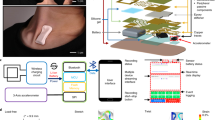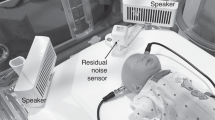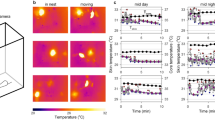Abstract
Objective:
To test a new system designed for digital recording of skin and air temperature, thereby allowing analysis of cyclic changes in temperature in neonates in servo-controlled incubators.
Methods:
Analysis of cyclic changes of serial skin and air temperature in asymptomatic infants in servo-controlled incubators adjusting heat output to the patient's temperature.
Results:
In nine asymptomatic neonates ranging from 25 to 40 weeks of gestational age, analysis showed peaks of coherence (squared correlation) between skin and air temperature measurements at periods ranging between 1.5 and 3?h.
Conclusion:
We have established a new system to study cyclic changes in skin and air temperature in neonates in servo-controlled incubators. The analysis of this pilot study suggests that the most important changes in skin and air temperature in asymptomatic neonates occur at a periodicity of 1.5 to 3?h, which is similar to that previously described for neonatal temperature. Additional data are required to determine whether this new system may be useful in neonatal care.
This is a preview of subscription content, access via your institution
Access options
Subscribe to this journal
Receive 12 print issues and online access
$259.00 per year
only $21.58 per issue
Buy this article
- Purchase on Springer Link
- Instant access to full article PDF
Prices may be subject to local taxes which are calculated during checkout

Similar content being viewed by others
References
Rivkees SA . Emergence and influences of circadian rhythmicity in infants. Clin Perinatol 2004; 31: 217–228.
Rivkees SA, Mirmiran M, Ariagno RL . Circadian rhythms in infants. NeoReviews 2003; 4: e298–e304.
Tenreiro S, Dowse HB, D'Souza S, Minors D, Chiswick M, Simms D et al. The development of ultradian and circadian rhythms in premature babies maintained in constant conditions. Early Hum Dev 1991; 27: 33–52.
Mirmiran M, Kok JH, de Kleine MJK, Koppe JG, Overdijk J, Witting W . Circadian rhythms in preterm infants: a preliminary study. Early Hum Dev 1990; 23: 139–146.
Konopka RJ, Benzer S . Clock mutants of Drosophila melanogaster. Proc Natl Acad Sci USA 1971; 68: 2112–2116.
Kyriacou CP, Greenacre ML, Ritchie MG, Peixoto AA, Shiels G, Hall JC . Genetic and molecular analysis of ultradian rhythms in Drosophila. In: Lloyd D, Rossi RL (eds). Ultradian Rhythms in Life Processes 1992, pp 89–105.
Mirmiran M, Maas YGH, Ariagno RL . Development of fetal and neonatal sleep and circadian rhythms. Sleep Med Rev 2003; 7: 321–334.
Bueno C, Diambra L, Menna-Barreto L . Sleep–wake and temperature rhythms in preterm babies maintained in a neonatal care unit. Sleep Res Online 2001; 4: 77–82.
Updike PA, Accurso FJ, Jones RH . Physiologic circadian rhythmicity in preterm infants. Nurs Res 1985; 34: 160–163.
Glotzbach SF, Edgar DM, Ariagno RL . Biological rhythmicity in preterm infants prior to discharge from neonatal intensive care. Pediatrics 1995; 95: 231–237.
Rivkees SA, Mayes L, Jacobs H, Gross I . Rest–activity patterns of premature infants are regulated by cycled lighting. Pediatrics 2004; 113: 833–839.
Thomas KA, Burr R . Preterm infant temperature circadian rhythm: possible effect of parental cosleeping. Biol Res Nurs 2002; 3: 150–159.
Weinert D, Sitka U, Minors DS, Waterhouse JM . The development of circadian rhythmicity in neonates. Early Hum Dev 1994; 36: 117–126.
Scher MS, Johnson MW, Holditch-Davis D . Cyclicity of neonatal sleep behaviors at 25 to 30 weeks' postconceptional age. Pediatr Res 2005; 57: 879–882.
Hellström-Westas L, Rosen I, Svenningsen NW . Cerebral function monitoring during the first week of life in extremely small low birthweight (ESLBW) infants. Neuropediatrics 1991; 22: 27–32.
Burdjalov VF, Baumgart S, Spitzer A . Cerebral function monitoring: a new scoring system for evaluation of brain maturation in neonates. Pediatrics 2003; 112: 855–861.
Olischar M, Klebermass K, Kuhle S, Hulek M, Kohlhauser C, Rücklinger E et al. Reference values for amplitude-integrated electroencephalographic activity in preterm infants younger than 30 weeks' gestational age. Pediatrics 2004; 113: e61–e66.
Kuhle S, Klebermass K, Olischar M, Hulek M, Prusa AR, Kohlhauser C et al. Sleep–wake cycles in preterm infants below 30 weeks of gestational age. Preliminary results of a prospective amplitude-integrated EEG study. Wien Klin Wochenschr 2001; 113: 219–223.
Sisman J, Campbell DE, Brion LP . Amplitude-integrated EEG in preterm infants: maturation of background pattern and amplitude voltage with gestational age and postmenstrual age. J Perinatol 2005; 25: 391–396.
Thomas KA . Biological rhythm development in preterm infants: does health status influence body temperature circadian rhythm? Res Nurs Health 2001; 24: 170–180.
Tsuji M, Saul JP, du Plessis A, Eichenwald E, Sobh J, Crocker R et al. Cerebral intravascular oxygenation correlates with mean arterial pressure in critically ill premature infants. Pediatrics 2000; 106: 625–632.
Jean-Louis M, Anwar M, Rosen H, Craelius W, Hiatt M, Hegyi T . Power spectral analysis of heart rate in relation to sleep position. Biol Neonate 2004; 86: 81–84.
Sinclair JC . Servo-control for maintaining abdominal skin temperature at 36°C in low birth weight infants. The Cochrane Database of Systematic Reviews 2002, Issue 1. Art. No. CD001074.
LeBlanc MH . Thermoregulation: incubators, radiant warmers, artificial skins, and body hoods. Clin Perinatol 1991; 18: 403–422.
Perlstein PH . Physical environment. In: Fanaroff A, Martin R (eds). Neonatal–Perinatal Medicine: Diseases of the Fetus and the Infant. Mosby: Philadelphia, PA, 1997, pp 481–501.
Dollberg S, Xi Y, Donnelly MM . A non-invasive transcutaneous alternative to rectal thermometry for continuous measurement of core temperature in the piglet. Pediatr Res 1993; 34: 512.
Gladstone IM, Ehrenkranz RA, Edberg SC, Baltimore RS . A ten-year review of neonatal sepsis and comparison with the previous fifty-year experience. Pediatr Infect Dis J 1990; 9: 819–825.
Glotzbach SF, Edgar DM, Ariagno RL . Biological rhythmicity in preterm infants prior to discharge from neonatal intensive care. Pediatrics 1995; 95: 231–237.
Bell EF, Rios GR . Air versus skin temperature servo control of infant incubators. J Pediatr 1983; 103: 954–959.
Schwartz H . Attenuation of warming and cooling cycles by shielding thermistor probes in infants nursed under radiant warmers. Adv Ther 1984; 1: 19–25.
Libert JP, Bach V, Farges G . Neutral temperature range in incubators: performance of equipment in current and new developments. Crit Rev Biomed Eng 1997; 25: 287–370.
Ludington-Hoe S, Nguyen N, Swinth JY, Satyshur RD . Kangaroo care compared to incubators in maintaining body warmth in preterm infants. Biol Res Nurs 2000; 2: 60–73.
Dolberg S, Atherton HD, Sigda M, Acree CM, Hoath SB . Effect of insulated skin probes to increase skin-to-environmental temperature gradients of preterm infants cared for in convective incubators. J Pediatr 124; 5: 799–801.
Mok Q, Bass CA, Ducker DA, McIntosh N . Temperature instability during nursing procedures in preterm neonates. Arch Dis Child 1991; 66: 783–786.
Moyer VA, Kennedy KA . Understanding and using diagnostic tests. Clin Perinatol 2003; 30: 189–204.
Acknowledgements
This study was supported by an equipment grant from Columbus Instruments, Columbus, OH. Preliminary data were presented at Mead Johnson Greater NY Perinatal Conference, White Plains, NY, 28 October 1999. We thank the nursing staff of the NICUs at Weiler Hospital and Moses Taylor Hospital.
Author information
Authors and Affiliations
Corresponding author
Rights and permissions
About this article
Cite this article
De La Fuente, L., Campbell, D., Rios, A. et al. Frequency analysis of air and skin temperature in neonates in servo-controlled incubators. J Perinatol 26, 301–305 (2006). https://doi.org/10.1038/sj.jp.7211491
Received:
Revised:
Accepted:
Published:
Issue Date:
DOI: https://doi.org/10.1038/sj.jp.7211491



